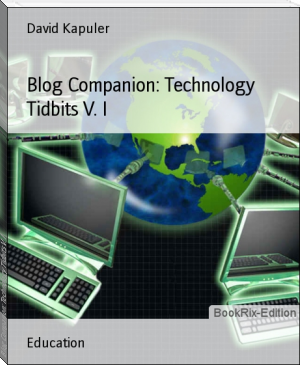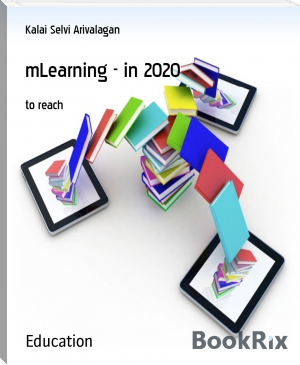INNOVATIONS IN SCIENCE, TECHNOLOGY AND MATHEMATICS EDUCATION IN NIGERIA by Ebele C. Okigbo, Nneka R. Nnorom, Ernest O. Onwukwe (the ebook reader .txt) 📖

- Author: Ebele C. Okigbo, Nneka R. Nnorom, Ernest O. Onwukwe
Book online «INNOVATIONS IN SCIENCE, TECHNOLOGY AND MATHEMATICS EDUCATION IN NIGERIA by Ebele C. Okigbo, Nneka R. Nnorom, Ernest O. Onwukwe (the ebook reader .txt) 📖». Author Ebele C. Okigbo, Nneka R. Nnorom, Ernest O. Onwukwe
Conclusion
In conclusion the study has revealed that pre-service science teachers perceived Science and Technology Education as a useful tool for empowerment of youths for food security. This can be achieved through use of scientific evidence to settle issues through practice. Science education can also provide useful economic empowerment strategies that can lead to job creation, income generation and this encourage youths to be gainfully employed in order to minimize crisis and restiveness and also improve food production to sustain our rural communities.
Implication of the findings
The encouragement received from the responses of these pre-service teachers towards empowering the youths through Science and Technology Education show that these trainee teachers have appreciated and viewed science and technology education as one of the useful tools for food security. They are also expected to inculcate acquired skills and techniques for food security in their students upon graduation. Secondly, they are expected to empower themselves through the application of scientific knowledge which they must have acquired during the course of their training for ensuring food security in their environment.
Recommendation
There is need for policy makers to include more scientific literacy aspirations that will improve scientific attitude and creativity in science education curriculum.
There is need for curriculum planers to redesign Science and Technology Education programme to include civic education as a general course where learners are exposed to national consciousness and patriotism. This will encourage science learners to work harder towards food production and suitability.
Government should support Science Education through the provision of grants for research for pre-service science teacher development and provision of infrastructure. This will help to improve the teaching and learning of science to foster scientific thinking which is needed for creativity, mechanized Agriculture and favourable adaption for Scio-Economic advancement in Nigeria. Science and Technology Education should start right from cradle to encourage students to establish private garden and life stock farming, young farmers club, and other co-operative approaches to solve issues of hunger and starvation.
References
F A O. (1996) Declaration on world food security and world food summit plan of Action. http://www.Fao/org/003W3613e/W361eoo.HTM.
FAO, WFP, IFAD (2012). The state of food insecurity in the world 2012 economic growth is necessary but not sufficient to accelerate reduction of hunger and malnutrition, FAO Rome.
FAO (2015). The state of food insecurity in the world, meeting the 2015International hunger targets: Taking stock of uneven progress, FAO in conjunction with IFAD and WFP, Rome.
Fletcher, A & Verves B (2006) Guide to school change led by and with young people, the free child Project.
Massoquoi, J. G. M (2006) Strengthening Peace building through Science and Technology Education. Proceedings of the International Council of Association for Science Education 113 – 119.
Obioma, G. O (2006). Resources for Science Mathematics and Technology (STM) Education in the context of education reforms in Nigeria. Proceedings of the 47th Annual Conference of STAN 3-7.
Ogbonia, J. C Nonura, N & Aoyagi, H (2013) Bioenergy production and food security in African. Academic Journal, 12, 7147 – 7157.
Omorogiuwa, O. Zivkovic, J. & Ademoh, F (2014) The role of agriculture in the economic development of Nigeria. European Scientific Journal, 10; 113 – 147.
Wasagu, M A & Rabi, M. (2009)Development entrepreneurial skills through STM Education. A path to Empowerment of Nigeria Women. Proceedings of STAN 50thAnnualConference , 209 – 211.
Young, K & Sazama, J. (2006). 15 Points to successfully involving youths in Decision making; Boston: Youth. O.
COMPARISON OF THE ACTIVITIES AND FLAMMMABLITY OF TWO FLAME RETARDANTS (CASTOR OIL AND AMMONIUM DIHYDROGEN PHOSPHATE) IN POLYURETHANE FOAM
Dr. U.G. Augustina Okeke
&
Cynthia C. Uwakwe
Abstract
The fire characteristics of two flame retardants, castor-oil and Ammoniumdihydrogen phosphate were compared to ascertain the most efficient flame retardant that can retard flame efficiently in polyurethane foam. Samples of polyurethane foams were produced and incorporated with castor oil and Ammoniumdihydrogen phosphate in various percentages (5-20%) and fire characteristics test were carried out on Add- on percentage, Ignition time, flame propagation rate, After-glow time, and char- formation of the foam which is compared to that of unretarded polyurethane foam. These properties were measured as function of concentration. Results showed that ignition time and Add-on percentage showed significant increase with concentration of flame retardant in castor oil than Ammoniumdihydrogen-phosphate (ADP) while flame propagation, char formation and after – glow time decreased more in castor oil than Ammoniumdihydrogen-phosphate (ADP) which are due to resistance in bond breaking process which reduce the flame propagation, glowing time and formation of char in castor oil than Ammoniumdihydrogen-phosphate. These results show that castor oil is more effective in retarding flame in polyurethane foam compared to Ammoniumdihydrogen Phosphate. It can be recommended that polyurethane foam manufacturers should incorporate castor oil flame retardant in their production of polyurethane foam.
Keywords: Activities, Flammmablity, Two Flame Retardants, Polyurethane Foam
Introduction
The term flame retardants subsume a diverse group of chemicals which are added to manufacturing materials, such as plastics and textiles, and surface finishes, coatings and polyurethane foams. Flame retardants are activated by the presence of an ignition source and are intended to prevent or slow the further development of ignition by a variety of different physical and chemical methods such as the endothermic degradation which breakdown some compounds, endothermally when they are subjected to high temperatures, its thermal shielding property which is a way to stop spreading of the flame over the material by creating a thermal insulation barrier between the burning and unburned parts (Hollingbery and Hull, 2012).
Castor oil is a well-known source of ricinoleic acid, a monosaturated, 18- carbon fatty acid which has a hydroxyl functional group on the 12th carbon which makes it more polar than most fats and can be used as a flame retardant. Due to its low reactivity with air and its dehydration properties due to its linoleic acid (Thomas and Alfred, 2005).
Ammonium dihydrogenphosphate (ADP) commonly called monoammonium phosphate (MAD) (monoammonium phosphate, 2015) is a chemical compound with formula NH6PO4. It is a white crystalline solid, an inorganic salt consisting of ammonium cations (NH4) + and dihydrogen phosphate anions (H2PO4) in equal proportions. It is comparable to ordinary table salt in workability, brittleness and solubility. It can be used as flame retardant for coating for wood, paper, fabric, dispersant for fiber processing and for polyurethane foam, (Ikeh, 2011)
Polyurethane foam is a polymer composed of organic unit joined by carbonate (urethane) links. Polyurethane polymers are formed by reacting a di- or tripoly-isocyanate with a polyol and other additives like water, binders, surfactant, cross linkers, flame retardant, blowing agents, pigment and fillers to modify the polymer. The main ingredients used in making polyurethane foams are isocyanate and polyols which are highly reactive and ignite easily. Therefore there is need to inculcate free retardant materials in it. Hence this present work will inculcate and compare the fire characteristics of two flame retardants; Castor oil and Ammonium dihydrogenphosphate in Polyurethane foam.
Though some halogenated flame retardants has been used to retard the flame in polyurethane foam but due to the fact that some of this halogenated flame retardant show some toxic effect to human health and environment (Hollingbery and Hull, 2010). Therefore there is a need to incorporate organic flame retardant like castor oil and inorganic flame retardants ( Phosphate compounds like Ammoniumdihydrogen – phosphate ) since they do not show signs of toxicity to man and its environment (Ikeh, 2011). Due to the high ignition rate and burning ratio of polyurethane materials there is always a need to incorporate flame retardants that are non toxic and can retard flame in the production of polyurethane foam, (Carigan and Mcclean, 2013; Onuegbu, Umoh and Iwuchukwu, 2012).
Hence this work comparison of the fire characteristics of two flame retardants (Castor oil and ammoniumdihydrogen-phosphate) in polyurethane foam.
Statement of the Problem
The fact that polyurethane foam burns easily and its applications in domestic and industrial areas are many, there is the need to inculcate some reasonable quantity of flame retardant into it during production. This will reduce the rate of flammability of the polyurethane.
Purpose of the Study
The main purpose of the study is to compare the activities and flammmablity of two flame retardants (castor oil and ammonium dihydrogenphosphate) in polyurethane foam. Specifically the study will investigate the following:
Fire characteristics of Polyurethane without fire retardant
Fire characteristics of Polyurethane, inculcated with castor oil
Fire characteristics of Polyurethane, inculcated with Ammonuim hydrogen phosphate
Compare the effectiveness of the two fire retardants
Research Questions
What are the fire characteristics of polyurethane without fire retandant?
What are the fire characteristics of Polyurethane foam retarded with castor oil?
What are the fire characteristics of Polyurethane foam retarded with Ammonuim hydrogen phosphate?
Which of the two fire retardant are more effective in polyurethane foam?
Collection of samples
The raw materials used in preparation of the polyurethane foam were collected and weighed according to intended formulation from profica chemical, Enugu. The flame retardants: castor oil and Ammoniumdihydrogen phosphate salt were purchased from Ogbete main market Enugu
Production of Polyurethane foam
The mould is constructed first, and the mould release i.e. Silicone oil is then applied around the mould so as to stop the foam from sticking in the mould, for easy removal of the produced foam. The formulation for the polyurethane formation is shown in table 1. Polyol, distilled water, silicone oil, stannous octoate, Dimethylethanolamine were thoroughly mixed in a plastic bucket. After -wards the toluene discocynate was added and stirred with a mechanical stirrer until the dispersion of reagent and foam of desirable structure to ensure reagents were well blended and the foaming process begins. The foam is now poured into the mould for it to foam. This first foam was the untreated foam which was not treated with a flame retardant and was used as blank. Then eight samples of treated polyurethane foams were produced; four samples incorporated with Ammoniumdihydrogen-phosphate and four incorporated with castor oil (Herington and Hock, 1991).
Table 1: Formation for the production of polyurethane foam Reagents are in grams (g)
Samples
Polyol
Stannous octoate
DMEA
Silicone oil
Water
TDI
Castor oil
ADP
Blank
212
0.4
0.2
1.8
6.8
88
0
0
FRA 1
212
0.4
0.2
1.8
6.8
88
0.05
0
FRA 2
212
0.4
0.2
1.8
6.8
88
0.1
0
FRA 3
212
0.4
0.2
1.8
6.8
88
0.15
0
FRA 4
212
0.4
0.2
1.8
6.8
88
0.2
0
FRAB 1
212
0.4
0.2
1.8
6.8
88
0
0.05
FRB 2
212
0.4
0.2
1.8
6.8
88
0
0.1
FRB 3
212
0.4
0.2
1.8
6.8
88
0
0.15
FRB 4
212
0.4
0.2
1.8
6.8
88
0
0.2
FRA- Foam incorporated with castor oil in various percentages
FRB- Foams incorporated with Ammoniumdihydrogen phosphate in different percentage.
Flame characteristics
Add-On %
The flexible polyurethane foams produced after incorporation with the flame retardant was weighed and the
 The desire to acquire knowledge about the surrounding world and human society is quite natural and understandable for a person. Life is so developed that an uneducated person will never occupy a high position in any field. Humanity in its mass, and each person individually, develops objectively, regardless of certain life circumstances and obstacles, but with different intensity. The speed of development depends on the quality of training.
The desire to acquire knowledge about the surrounding world and human society is quite natural and understandable for a person. Life is so developed that an uneducated person will never occupy a high position in any field. Humanity in its mass, and each person individually, develops objectively, regardless of certain life circumstances and obstacles, but with different intensity. The speed of development depends on the quality of training.




Comments (0)